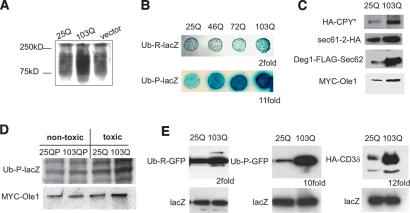Figure 1.
PolyQ-expanded htt exonI selectively impaired UFD and ERAD. (A) Yeast cells expressing polyQ-expanded htt exonI accumulate polyubiquitinated proteins. Protein lysates from yeast cells expressing either 25Q or 103Q htt exonI for 12 h or a vector control were analyzed by Western blotting using an anti-ubiquitin antibody. (B) Longer polyQ expansions caused stronger inhibition of UFD in yeast. The N-end rule reporter protein, Ub-R-lacZ, and the UFD reporter protein Ub-P-lacZ were expressed in yeast cells that expressed htt exonI fragments with 25Q, 46Q, 72Q, and 103Q for 6 h. Turnover of the N-end rule and UFD reporter proteins was visualized by a β-galactosidase overlay assay. (C) 103Q htt exonI impairs ERAD in yeast. Western blot analysis of protein lysates from yeast cells expressing the ERAD reporter proteins HA-CPY*, sec61-2-HA, Deg1-Flag-Sec62, and MYC-Ole1 coexpressing either 25Q or 103Q htt exonI for 6 h. (D) Only toxic polyQ-expanded htt exonI impaired UFD and ERAD. Western blot analysis of protein lysates from yeast cells expressing either the nontoxic htt exonI proteins 25QP, 103QP, and 25Q or the toxic 103Q for 6 h. These cells coexpressed either the UFD reporter (Ub-P-lacZ) or the ERAD reporter (MYC-Ole1). (E) UFD and ERAD were impaired in PC12 cells expressing 103Q htt exonI. PC12 cells harboring inducible versions of 25Q or 103Q htt exonI were transfected with the N-end rule reporter Ub-R-GFP, the UFD-reporter Ub-P-GFP, and the ERAD reporter HA-CD3δ. For all transfections, a plasmid for the expression of lacZ was cotransfected. Two days after transfection, 25Q and 103Q expression was induced for 8 h, cells were lysed, and Western blot analyses were performed. Equal protein loading for the Western blots shown in this figure was documented by the levels of the transfection control lacZ. The numbers below the Western blots indicate the quantification of the fold stabilization of the degradation substrate in cells expressing 103Q compared with cells expressing 25Q (average of three independent experiments).

